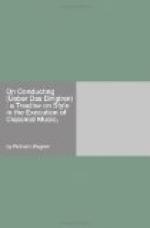Suppose a conductor were to attempt to hold the fermata as here directed, what would be the result? A miserable failure. After the initial power of the bow of the stringed instruments had been wasted, their tone would become thin and thinner, ending in a week and timid piano: for—(and here is one of the results of indifferent conducting)—our orchestras now-a-days hardly know what is meant by equally sustained tone. Let any conductor ask any orchestral instrument, no matter which, for a full and prolonged forte, and he will find the player puzzled, and will be astonished at the trouble it takes to get what he asks for.
Yet tone sustained with equal power is the basis of all expression, [footnote: Die Basis aller Dynamik.] with the voice as with the orchestra: the manifold modifications of the power of tone, which constitute one of the principal elements of musical expression, rest upon it. Without such basis an orchestra will produce much noise but no power. And this is one of the first symptoms of the weakness of most of our orchestral performances. The conductors of the day care little about a sustained forte, but they are particularly fond of an exaggerated piano. Now the strings produce the latter with ease, but the wind instruments, particularly the wood winds do not. It is almost impossible to get a delicately sustained piano from wind instruments.
The players, flautists particularly, have transformed their formerly delicate instruments into formidable tubes (Gewaltsrohren). French oboists, who have preserved the pastoral character of their instrument, and our clarinetists, when they make use of the “Echo effect,” are the exceptions.
This drawback, which exists in our best orchestras, suggests the question: why, at least, do not conductors try to equalise matters by demanding a somewhat fuller piano from the strings? But the conductors do not seem to notice any discrepancy.
To a considerable extent the fault lies not so much with the wind instruments, as in the character of the piano of the strings; for we do not possess a true piano, just as we do not possess a true forte; both are wanting in fulness of tone—to attain which our stringed instruments should watch the tone of the winds. Of course it is easy enough to produce a buzzing vibration by gently passing the bow over the strings; but it requires great artistic command of the breath to produce a delicate and pure tone upon a wind instrument. Players of stringed instruments should copy the full-toned piano of the best winds, and the latter, again, should endeavour to imitate the best vocalists.
The sustained soft tone here spoken of, and the sustained powerful tone mentioned above, are the two poles of orchestral expression. [Footnote: Dynamik des Orchesters.]




